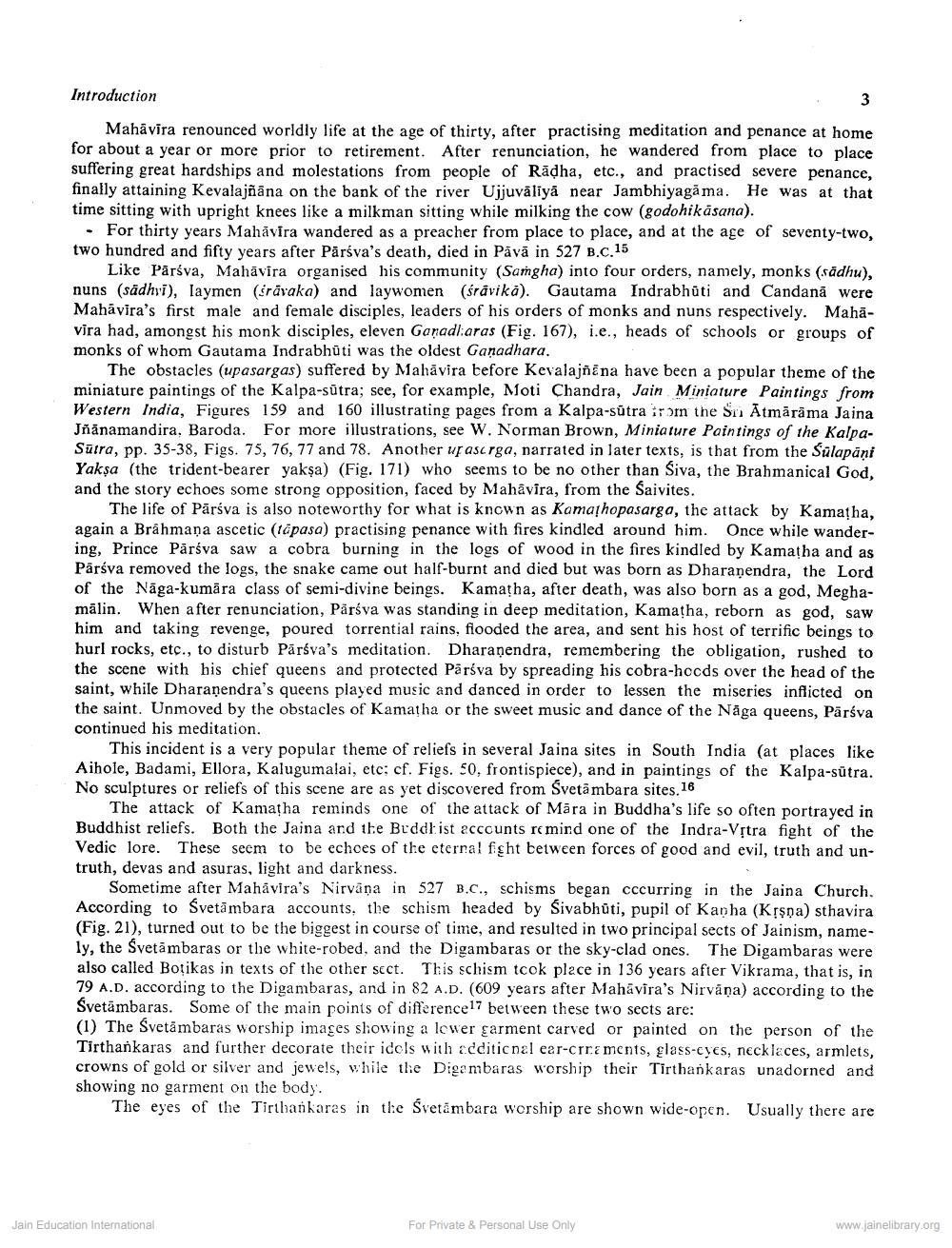________________
Introduction
3
Mahavira renounced worldly life at the age of thirty, after practising meditation and penance at home for about a year or more prior to retirement. After renunciation, he wandered from place to place suffering great hardships and molestations from people of Rādha, etc., and practised severe penance, finally attaining Kevalajñāna on the bank of the river Ujjuväliya near Jambhiyagama. He was at that time sitting with upright knees like a milkman sitting while milking the cow (godohikásana).
. For thirty years Mahavira wandered as a preacher from place to place, and at the age of seventy-two, two hundred and fifty years after Pārsva's death, died in Pāvā in 527 B.C.15
Like Parśva, Mahāvira organised his community (Saṁgha) into four orders, namely, monks (sādhu), nuns (sādhvi), laymen (srävaka) and laywomen (śrávika). Gautama Indrabhūti and Candanã were Mahāvira's first male and female disciples, leaders of his orders of monks and nuns respectively. Mahavira had, amongst his monk disciples, eleven Ganadlaras (Fig. 167), i.e., heads of schools or groups of monks of whom Gautama Indrabhūti was the oldest Ganadhara.
The obstacles (upasargas) suffered by Mahāvira before Kevalajñana have been a popular theme of the miniature paintings of the Kalpa-sutra; see, for example, Moti Chandra, Jain Miniature Paintings from Western India, Figures 159 and 160 illustrating pages from a Kalpa-sútra irom the Sm Ātmäräma Jaina Jñanamandira. Baroda. For more illustrations, see W. Norman Brown, Miniature Paintings of the KalpaSutra, pp. 35-38, Figs. 75, 76, 77 and 78. Another upasurga, narrated in later texts, is that from the Sulapāņi Yaksa (the trident-bearer yakşa) (Fig. 171) who seems to be no other than Siva, the Brahmanical God. and the story echoes some strong opposition, faced by Mahavira, from the Saivites.
The life of Pārsva is also noteworthy for what is known as Kamashopasarga, the attack by Kamatha, again a Brahmana ascetic (tapasa) practising penance with fires kindled around him. Once while wandering, Prince Pārśva saw a cobra burning in the logs of wood in the fires kindled by Kamatha and as Pärśva removed the logs, the snake came out half-burnt and died but was born as Dharanendra, the Lord of the Näga-kumāra class of semi-divine beings. Kamatha, after death, was also born as a god, Meghamālin. When after renunciation, Párśva was standing in deep meditation, Kamatha, reborn as god, saw him and taking revenge, poured torrential rains, flooded the area, and sent his host of terrific beings to hurl rocks, etc., to disturb Pärsva's meditation. Dharanendra, remembering the obligation, rushed to the scene with his chief queens and protected Pārsva by spreading his cobra-hocds over the head of the saint, while Dharanendra's queens played music and danced in order to lessen the miseries inflicted on the saint. Unmoved by the obstacles of Kamatha or the sweet music and dance of the Nāga queens, Päráva continued his meditation.
This incident is a very popular theme of reliefs in several Jaina sites in South India (at places like Aihole, Badami, Ellora, Kalugumalai, etc; cf. Figs. 50, frontispiece), and in paintings of the Kalpa-sútra. No sculptures or reliefs of this scene are as yet discovered from Svetā mbara sites. 16
The attack of Kamatha reminds one of the attack of Māra in Buddha's life so often portrayed in Buddhist reliefs. Both the Jaina and the Buddhist accounts remind one of the Indra-Vstra fight of the Vedic lore. These seem to be echoes of the eternal fight between forces of good and evil, truth and untruth, devas and asuras, light and darkness.
Sometime after Mahavira's Nirvana in 527 B.C., schisms began cccurring in the Jaina Church. According to Svetāmbara accounts, the schism headed by Sivabhūti, pupil of Kanha (Krsna sthavira (Fig. 21), turned out to be the biggest in course of time, and resulted in two principal sects of Jainism, namely, the Svetämbaras or the white-robed, and the Digambaras or the sky-clad ones. The Digambaras were also called Botikas in texts of the other sect. This schism took place in 136 years after Vikrama, that is, in 79 A.D. according to the Digambaras, and in 82 A.D. (609 years after Mahavira's Nirvāna) according to the Svetämbaras. Some of the main points of difference17 between these two sects are: (1) The Svetämbaras worship images showing a lower garment carved or painted on the person of the Tirthankaras and further decorate their idols with additicnal ear-crraments, glass-cyes, necklaces, armlets, crowns of gold or silver and jewels, while the Digambaras worship their Tirthankaras unadorned and showing no garment on the body.
The eyes of the Tirthankaras in the Svetambara worship are shown wide-open. Usually there are
Jain Education International
For Private & Personal Use Only
www.jainelibrary.org




